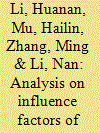|
|
|
Sort Order |
|
|
|
Items / Page
|
|
|
|
|
|
|
| Srl | Item |
| 1 |
ID:
110363


|
|
|
|
|
| Publication |
2011.
|
| Summary/Abstract |
With the intensification of global warming and continued growth in energy consumption, China is facing increasing pressure to cut its CO2 (carbon dioxide) emissions down. This paper discusses the driving forces influencing China's CO2 emissions based on Path-STIRPAT model-a method combining Path analysis with STIRPAT (stochastic impacts by regression on population, affluence and technology) model. The analysis shows that GDP per capita (A), industrial structure (IS), population (P), urbanization level (R) and technology level (T) are the main factors influencing China's CO2 emissions, which exert an influence interactively and collaboratively. The sequence of the size of factors' direct influence on China's CO2 emission is A>T>P>R>IS, while that of factors' total influence is A>R>P>T>IS. One percent increase in A, IS, P, R and T leads to 0.44, 1.58, 1.31, 1.12 and -1.09 percentage change in CO2 emission totally, where their direct contribution is 0.45, 0.07, 0.63, 0.08, 0.92, respectively. Improving T is the most important way for CO2 reduction in China.
|
|
|
|
|
|
|
|
|
|
|
|
|
|
|
|
| 2 |
ID:
132640


|
|
|
|
|
| Publication |
2014.
|
| Summary/Abstract |
There has been much attention paid to oil security in China in recent years. Although China has begun to establish its own strategic petroleum reserve (SPR) to prevent potential losses caused by oil supply interruptions, the system aiming to ensure China×s oil security is still incomplete. This paper describes and provides evidence for the benefits of an auxiliary strategic oil policy choice, which aims to strengthen China×s oil supply security and offer a solution for strategic oil operations with different holding costs. In this paper, we develop a multi-dimension stochastic dynamic programming model to analyze the oil stockpile delegation policy, which is an intermediate policy between public and private oil stockpiles and is appropriate for the Chinese immature private oil stockpile sector. The model examines the effects of the oil stockpile delegation policy in the context of several distinct situations, including normal world oil market conditions, slight oil supply interruption, and serious oil supply interruption. Operating strategies that respond to different oil supply situations for both the SPR and the delegated oil stockpile were obtained. Different time horizons, interruption times and holding costs of delegated oil stockpiles were examined. The construction process of China×s SPR was also taken into account.
|
|
|
|
|
|
|
|
|
|
|
|
|
|
|
|
|
|
|
|
|